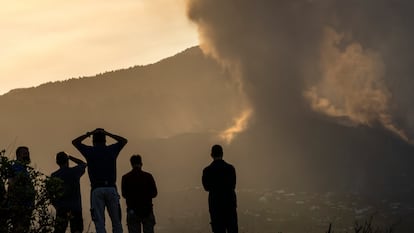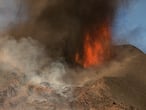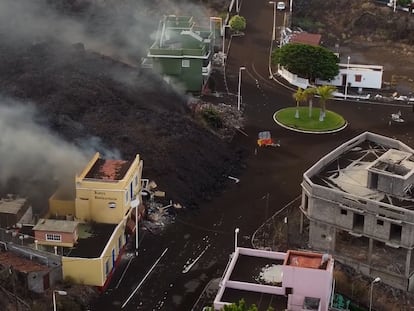Volcanic activity increases on La Palma, prompting new evacuations and flight cancelations
Fire crews have had to withdraw from the neighborhood of Todoque due to increased pyroclastic material and ash being expelled. The Cabinet will declare the area a disaster zone next week

Activity at the new volcano that erupted on Sunday on the Canary Island of La Palma greatly increased on Friday afternoon, prompting the authorities to evacuate more nearby municipalities and cancel flights. A series of explosions have been heard throughout the day, while more pyroclastic material and ash was being spewed out from the Cumbre Vieja area. What’s more, a new vent has opened up, from which lava is flowing.
Around a thousand people have had to be evacuated from the areas of Tajuya (644 inhabitants) and Tacande de Abajo (319), as well as the part of Tacande de Arriba that had not already been cleared of residents (385).
Meanwhile, airlines Iberia, Binter and Canaryfly have had to suspend all of their flights to and from La Palma, which is part of Spain’s Canary Islands, located off the northwestern coast of Africa.
Este mediodía se están registrando muchas explosiones intensas en el cono principal del volcán, las ventanas a punto de reventar. El vídeo lo he tomado en la parroquía La Sagrada Familia de El Paso, a unos tres kilómetros del cráter. Ahora hemos tenido otra mucho más fuerte 😟 pic.twitter.com/McwfFQIzts
— Javier Salas (@javisalas) September 24, 2021
One of the explosions caught on camera today on La Palma.
The firefighters in the neighborhood of Todoque had to withdraw from the area due to the increasing amount of pyroclastic material and ash that was falling in the area.
The explosions had become much more frequent by Friday evening and were audible in all areas of the municipalities of El Paso, where the volcano is located, and Los Llanos de Aridane, which is the most-populated area of the island.
The Civil Guard also evacuated the area three kilometers from the volcano where the National Geographic Institute had set up its operation center, clearing the area of onlookers and journalists who were broadcasting from the spot, located next to La Sagrada Familia church.
Sidewalk cafés in El Paso were left deserted as members of the public sought shelter inside and followed developments on the television. They were also fleeing from the ever-increasing ash, the continuous passing of emergency vehicles, and the impact of the shockwaves from the explosions, which are rattling the windows of buildings throughout the municipality. All of this was taking place under the dark skies caused by the smoke from the eruption.
The regional premier of the Canary Islands government, Ángel Víctor Torres, announced on Friday that a first round of financial aid, worth €13 million, would be released for those affected by the volcano, lava from which has completely destroyed hundreds of homes and other properties. Spain’s Prime Minister Pedro Sánchez also announced today that the Cabinet would next week designate the island as a disaster zone.
Based on reporting by Guillermo Vega and Javier Salas.
English version by Simon Hunter.
Tu suscripción se está usando en otro dispositivo
¿Quieres añadir otro usuario a tu suscripción?
Si continúas leyendo en este dispositivo, no se podrá leer en el otro.
FlechaTu suscripción se está usando en otro dispositivo y solo puedes acceder a EL PAÍS desde un dispositivo a la vez.
Si quieres compartir tu cuenta, cambia tu suscripción a la modalidad Premium, así podrás añadir otro usuario. Cada uno accederá con su propia cuenta de email, lo que os permitirá personalizar vuestra experiencia en EL PAÍS.
¿Tienes una suscripción de empresa? Accede aquí para contratar más cuentas.
En el caso de no saber quién está usando tu cuenta, te recomendamos cambiar tu contraseña aquí.
Si decides continuar compartiendo tu cuenta, este mensaje se mostrará en tu dispositivo y en el de la otra persona que está usando tu cuenta de forma indefinida, afectando a tu experiencia de lectura. Puedes consultar aquí los términos y condiciones de la suscripción digital.
More information
Últimas noticias
The complicated life of Francesca Albanese: A rising figure in Italy but barred from every bank by Trump’s sanctions
How Japan is trying to avert ‘digital defeat’
Half of Scotland is in the hands of 420 property owners
Reinhard Genzel, Nobel laureate in physics: ‘One-minute videos will never give you the truth’
Most viewed
- Pablo Escobar’s hippos: A serious environmental problem, 40 years on
- Reinhard Genzel, Nobel laureate in physics: ‘One-minute videos will never give you the truth’
- Why we lost the habit of sleeping in two segments and how that changed our sense of time
- Charles Dubouloz, mountaineering star, retires at 36 with a farewell tour inspired by Walter Bonatti
- The Florida Keys tourist paradise is besieged by immigration agents: ‘We’ve never seen anything like this’










































